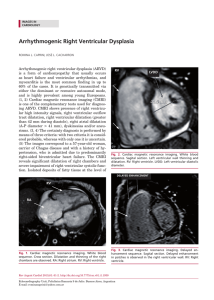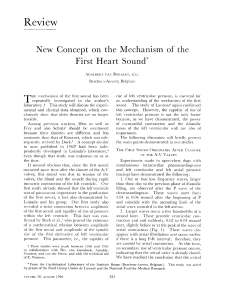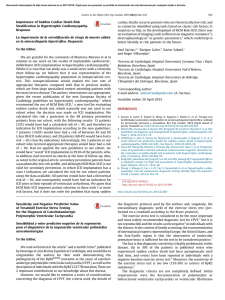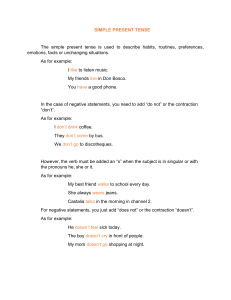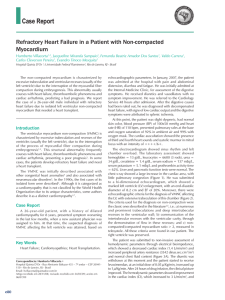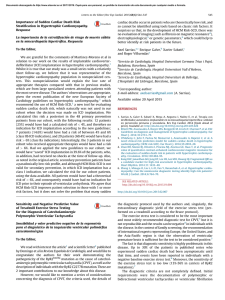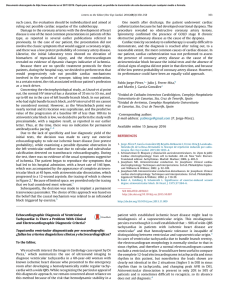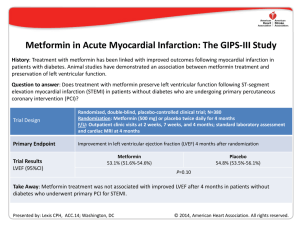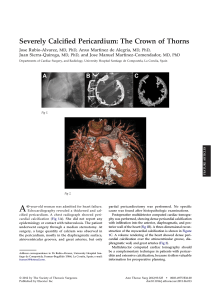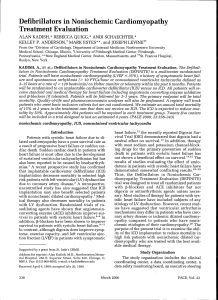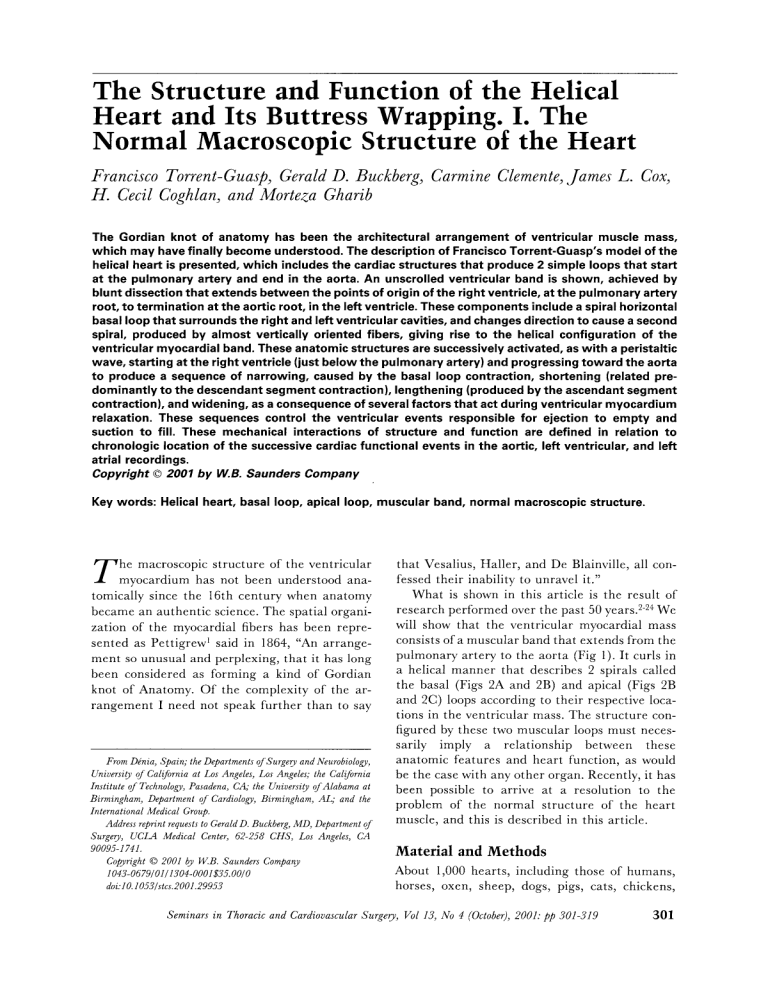
The Structure and Function of the Helical Heart and Its Buttress Wrapping. I. The Normal Macroscopic Structure of the Heart Francisco Torrent-Guasp) Gerald D. Buckberg) Carmine Clemente) James L. Cox) H. Cecil Coghlan) and Morteza Gharib The Gordian knot of anatomy has been the architectural arrangement of ventricular muscle mass, which may have finally become understood. The description of Francisco Torrent-Guasp's model of the helical heart is presented, which includes the cardiac structures that produce 2 simple loops that start at the pulmonary artery and end in the aorta. An unscrolled ventricular band is shown, achieved by blunt dissection that extends between the points of origin of the right ventricle, at the pulmonary artery root, to termination at the aortic root, in the left ventricle. These components include a spiral horizontal basal loop that surrounds the right and left ventricular cavities, and changes direction to cause a second spiral, produced by almost vertically oriented fibers, giving rise to the helical configuration of the ventricular myocardial band. These anatomic structures are successively activated, as with a peristaltic wave, starting at the right ventricle (just below the pulmonary artery) and progressing toward the aorta to produce a sequence of narrowing, caused by the basal loop contraction, shortening (related predominantly to the descendant segment contraction), lengthening (produced by the ascendant segment contraction), and widening, as a consequence of several factors that act during ventricular myocardium relaxation. These sequences control the ventricular events responsible for ejection to empty and suction to fill. These mechanical interactions of structure and function are defined in relation to chronologic location of the successive cardiac functional events in the aortic, left ventricular, and left atrial recordings. Copyright © 2001 by W.B. Saunders Company Key words: Helical heart, basal loop, apical loop, muscular band, normal macroscopic structure. T he macroscopic structure of the ventricular myocardium has not been understood anatomically since the 16th century when anatomy became an authentic science. The spatial organization of the myocardial fibers has been represented as Pettigrew l said in 1864, "An arrangement so unusual and perplexing, that it has long been considered as forming a kind of Gordian knot of Anatomy. Of the complexity of the arrangement I need not speak further than to say From Denia, Spain; the Departments of Surgery and Neurobiology, University of California at Los Angeles, Los Angeles; the California Institute of Technology, Pasadena, CA; the University of Alabama at Birmingham, Department of Cardiology, Birmingham, AL; and the International Medical Group. Address reprint requests to Gerald D. Buckberg, MD, Department of Surgery, UCLA Medical Center, 62-258 CHS, Los Angeles, CA 90095-1741. Copyright © 2001 by WE. Saunders Company 1043-0679/01/1304-0001 $35.00/0 doi: 10.1 053/ stcs.200 1.29953 that Vesalius, Haller, and De Blainville, all confessed their inability to unravel it." What is shown in this article is the result of research performed over the past 50 years. 2-24 We will show that the ventricular myocardial mass consists of a muscular band that extends from the pulmonary artery to the aorta (Fig I). It curls in a helical manner that describes 2 spirals called the basal (Figs 2A and 2B) and apical (Figs 2B and 2C) loops according to their respective locations in the ventricular mass. The structure configured by these two muscular loops must necessarily imply a relationship between these anatomic features and heart function, as would be the case with any other organ. Recently, it has been possible to arrive at a resolution to the problem of the normal structure of the heart muscle, and this is described in this article. Material and Methods About 1,000 hearts, including those of humans, horses, oxen, sheep, dogs, pigs, cats, chickens, Seminars in Thoracic and Cardiovascular Surgery, Vol 13, No 4 (October), 2001: pp 301-319 301 302 Torrent-Guasp et al Figure 1. Five successive phases of the unwinding of the ventricular myocardial band. In the first specimen (upper left) the band appears in its normal position, as it is in the intact heart. In the last specimen (bottom), the band is fully extended. rabbits, turtles, lizards, fish, and sharks, and the circulatory system of worms have been studied. The hearts were boiled in water to soften the connective tissue. The boiling time was determined empirically depending on the appearance of the muscle and on the size of the specimen; 5 minutes or less for a chicken heart and up to 2 hours for an adult ox heart. Then the aorta and pulmonary artery were removed. The fat in the atrioventricular sulcus was excised, as were the superficial coronary vessels. Dissection can begin after preparation of the specimen, but an important factor must be considered. When we describe fibers, fascicles, or bands of myocardium, we do not intend that these are specific anatomic structures that are exactly observed with precision in different hearts. A selected muscular mass shows certain preferred trajectories visualized along the longitudinal axis of any muscular strip. These trajectories are reproducible at any region of the ventricular myocardium in all hearts. Therefore, when we refer to fiber or to layer we are dealing, respectively, with a linear pathway or a laminar pathway. The form and size of these linear (Fig 3E) or laminar (Figs 3C and 3D) muscle pathways (also called sliding planes; plans de cleavage; planas de desli;:;amiento) are virtually unlimited and can be endlessly different. That is why when we discuss myocardial units in this article, we really refer to pathways rather than to fibers. The myocardial units have a functional personality rather than a strict morphologic personality because the morphology of any fiber cannot be exactly reproduced in different hearts but the results of their action, as happens in any other muscle when contracting along their longitudinal axis between two points, are constant depending of the orientation in the space of those linear or laminar muscular pathways. The action performed by every fiber, each one of them with a corresponding preferential path that is constant and reproducible in all hearts, represents, therefore, the true myocardial units, which are true functional units, not morphologic ones. Anatomic blunt dissections were made by using only our fingers, and no instruments were used, such as forceps, scalpels, or scissors. This was the most satisfactory means of identifying the direction of the linear (fiber) and laminar (layer) pathways. Gentle longitudinal traction was enough to separate long strips of myocardium, whereas forcible lateral traction tended to tear muscle tissue A semantic point: in anatomy, apical means top or above and, therefore, it is not exactly appropriate to use this term in relation to the apex of the heart but, nevertheless, it will be used Normal Macroscopic Structure 303 in this text because it has been hollowed by usage and it will be understood by all. 8 A c e o • right \~ 11 11 " • segmont scgmenl ______ ______ ~. basal loop descendenl segment ____ Jn~ • ascendent segmenl ~.~ ____J' apical loop Figure 2. Schematic representation of the ventricular myocardial band (compare with the specimens in Fig I). (A) The band in its normal position. (B) The pulmonary artery (PA) has been separated; the right free wall and the septum define a dihedral angel (see arrow and the two parallelograms) that show the linear posterior limit of the right ventricular cavity; this anatomic fact points out the beginning of a cleavage plane along which is the root of the aorta (b, at A). (C) The separation of the right free wall has been completed. Shown is a 90 0 crossing of horizontal fibers (Ds) with vertical ones (As). The intraseptal fibers (IF) and the aberrant fibers (AF, they appear cut) are originated in the ascendant segment at the anterior aspect of the left ventricle. (D) Those vertical fibers (AS and if) are separated when dismounting the aorta (Ao) after cutting both fibrous trigones, the left (It) and the right (rt). The helical trajectory followed by the ventricular myocardial band becomes evident. (E) The band has been extended. Pulmonary artery root, A; central fold, B; aortic root, C; posterior interventricular sulcus, D and D' (the 2 double-dotted lines coincide when the band is rolled up); virtual apical orifice, E; pulmotricuspidalis cord (pte). apm, anterior papillary muscle; ppm, posterior papillary muscle. Dissection of the Ventricular Band In general, arrangement of the morphologic plan of the myocardium can easily take into account 3 anatomic facts: (l) the anterior interventricular sulcus, along which can be separated the right free wall, (2) the posterior linear limit of the right ventricular cavity, which shows the beginning of a cleavage plane or laminar trajectory that runs in the inside of the left ventricular wall, and (3) the 90° crossing of fibers at the septum that points out the beginning of the final cleavage plane that completes the dissection. Three stages must be followed sequentially to unroll the ventricular myocardium: First stage: unwinding the basal loop. The more superficial fibers on the anterior aspect of the left ventricle, called aberrant fibers, must be cut where they cross over the anterior interventricular sulcus (Fig 2A, dotted line, see arrow) onto the right ventricle. In this manner, the right free wall (Fig 2B) can be separated and opened. Dissection continues by following the cleavage plane initiated at the posterior limit of the right ventricular cavity. This limit, represented by the arista of the dihedral angle defined by the septum and the right free wall (see arrow and the two parallelograms in Fig 2B), shows the beginning of the cleavage plane that extends finishing close to the aortic root (B in Fig 2C). In this manner the unwinding of the basal loop is completed (see also Fig 2D where the basal loop stretches from insert A to insert B). Second stage: dismounting the aorta. Both the right and left trigones (It and rt in Fig 2D) must be sectioned to dismount the aorta, which is fixed, by means of both trigones, on the descendant segment (DS in Figs 2C and 2D). Third stage: unwinding the apical loop. Dissection continues along the cleavage plane defined by the right angle crossing (arrow, Fig 2C) of the descending (Ds) and ascending (As and If) muscular strata. Description The muscular pattern described in this article was found in the hearts of all birds and mammals studied, including humans. Although our findings 304 Torrent-Guasp et at c are relevant to the human heart, many dissections were performed on the bovine heart, which are more easily available. The same morphologic features were shown in both bovine and human hearts. Four fundamental anatomic facts become evident in the following sequential order: 1. Left ventricle: apical half. The apex, which is part of the left ventricle, reflects the site of the vortex where the subepicardial fibers become subendocardial, a fact known for any anatomist since more than five centuries ago. Figure 4 shows the laminar organization of the muscle fiber groups that form the apex of the heart. These fascicles course in a helical manner from periphery to center. They then twist subendocardially around a tunnel that is closed on the outside by epicardium and on the inside by endocardium. Another way to show this arrangement of overlapping muscular layers is to dissect alternate groups of fibers (Fig 4); in this way, that tunnel or orifice at the apex becomes enlarged. This will show the circular overlapping muscular layers that run from the epicardium toward the endocardium (Fig 5). 2. Left ventricle: basal half. There is also a consistent arrangement of the fibers in the basal region of the free wall of the left ventricle. Blunt dissection at this site reveals many lam- Figure 3. (A) A quadrangular piece of myocardium is schematically represented. The most relevant myocardial elements are united by small oblique lateral branches. (B) Selecting arbitrarily planes a, b, and c, (C and D) 2 laminar trajectories, and (E) I linear trajectory are pointed out (the fibers that show such trajectories appear with their tops in black). inar trajectories (Fig 6) that take a helical trajectory from the periphery to the center, similar in structure to that observed in the apex. Figure 7 shows overlapping muscle layers defined by grooves that separate intact fibers. This was achieved by dissecting alternate groups of fibers. Note that the fibers pass Figure 4. Transverse cut, near the apex, of the ventricular mass. Several muscular layers have been dissected. At the apex, the subepicardial fibers become subendocardial around a tunnel (which is closed, inside, by the endocardium and outside by the epicardium; E in Fig 2C). 305 Normal Macroscopic Structure ventricle (Fig 9) corresponds to that found in the basal half of the left ventricle (Fig 7) and in both apical regions (Fig 8). The Architectural General Plan of the Ventricular Myocardium From these 4 anatomic observations a consistent architectural pattern (represented by overlap- B AIS Figure 5. Overlapping muscular layers at the apex. Outside view. Removal of the more superficial fibers has enlarged the apical tunnel (shown in Fig 4 and in E in Fig 2C). LV, left ventricular cavity; AlS, anterior interventricular sulcus. from the outside to the inside of the ventricular wall without inserting into the mitral ring (only the most superficial fibers, which have been excised in this specimen, are inserted in such ring). 3. Right ventricle: apical half. Dissection of alternate groups of fibers in the apical half of the free wall of the right ventricle reveals again a series of overlapping muscle layers defined by corresponding laminar trajectories (Fig 8). 4. Right ventricle: basal half. In our dissection we showed that the myocardial arrangement in the basal half of the free wall of the right Ao ~-· 10 Figure 6. Basal third of the ventricular mass. Several layers, separated by corresponding preferential laminar pathways, have been dissected in the left free wall. TO, tricuspid orifice; Mo, mitral orifice; Ao, aorta; PA, pulmonary artery. 306 Torrent-Guasp et at inside, running from right to left, whereas at the apex they course from the outside to the inside, running from left to right. It can be seen in Figures IIA through liD that the muscular trajectories and rope bundles always course parallel. Another clear difference is the thickness of the 8 Figure 7. Dissecting alternate groups of fibers at the ventricular base, it can be seen that the fibers of the left free wall, imbricated as the pieces of a roof, pass from the external to the internal surface of the ventricular cavity without becoming inserted in the mitral ring. The tricuspid ring only connects the atria to the ventricular myocardium, with limited morphologic structural strength. ping or imbricated muscle layers), was identified at both the basal and apical halves of the ventricles. But there is a clear difference between the structures at the basal and apical regions because at the base of the ventricles the helical course of the fibers from the epicardium to the endocardium runs in an opposite direction to those at the apex. A rope model shows this fact in Figure 10. At the base (Figs IIC and lID), the muscle fibers (and rope bundles) course from the outside to the Figure 8. Apical half of the ventricles, right lateral view. An alternate group of fibers have been dissected to show the overlapping muscular layer structure of this region of the heart. PIS, posterior interventricular sulcus. Normal Macroscopic Structure 307 artery and at the root of the aorta. Therefore, the rope model of Figures lOC, IIA, lIB, and 12A, should be modified in the manner seen in Figure 12C. We conclude that the ventricular myocardium consists of a single muscle band (Fig 13) that, twisted on itself as seen in the rope model, extends from the origin of the pulmonary artery to the root of the aorta. This defines two turns in a helical fashion and delimitates two cavities, the right and left ventricles. Segmentation of the Ventricular Myocardial Band FW As seen in Figure 2E, the ventricular myocardial band extends from the root of the pulmonary artery (A) to the root of the aorta (C). It is divided into two parts by a fold (B) at its center. In their normal anatomy, each of these two parts forms a loop: A-B represents the basal loop and B-C represents the apical loop (see also Figs 2A-D). Each of the two loops, in turn, is divided into two segments. In the basal loop the posterior interventricular sulcus (double dotted line D in Fig 2E) separates the right segment (RS), which constitutes the right free wall, and the left segment (LS), which forms the left free wall. In the apical loop, the posterior papillary muscle (ppm) separates (double dotted line D') the descendant segment (DS) and the ascendant segment (AS). The Interventricular Septum Figure 9. Ventricular base. Dissection of alternate groups of fibers shows, once more, an overlapping muscular layer structure. The fibers pass from the external to the internal surfaces of the right free wall without being inserted in the tricuspid ring. Mao, mitroaortic orifice; FW, right free wall. ventricular walls. In Figures lIB and 11C it can be seen that the left free wall consists of two loops, and it is thicker than the right free wall, which consists only of one loop. The ventricular myocardium constitutes a muscle band twisted on itself as shown by the rope model. By means of his phylogenetic concepts, Torrent-Guasp arrived to the conclusion that the origin and the end of that muscle band were, respectively, at the root of the pulmonary 1. The interventricular septum is formed by three muscular strata (bottom cartoon in Fig 14). 1. The right stratum. This stratum is represented by fibers (Rf in Figs 2B and 2C) of the right free wall that, on reaching the anterior interventricular sulcus (top cartoon in Fig 14), reflects coming up to cover, subendocardially, the right surface of the septum (bottom cartoon of Fig 14). These recurrent fibers insert at the tricuspid and pulmonary rings and along the pulmotricuspid fibrous cord (Ptc at Fig 2E) that is extended between these two nngs. 2. The middle stratum. This stratum consists of the fibers of the ascendant segment (AS and If at Fig 2C). These course upward to terminate at the root of the aorta (see bottom cartoon at Fig 14). 3. The left stratum. This stratum consists of fibers of the descendant segment (bottom car- 308 Torrent-Guasp et al Figure 10. A rope model can show the architectural plan of the ventricular myocardium. A, B, C, the 3 successive stages of its preparation. toon at Fig 14 and Ds in Fig 2D) that, coming from the left segment (Ls in Fig 2D), course down, following a spiral path, and when arriving at the level of the posterior interventricular sulcus (D and D' in Fig 2E) changes their course to become the fibers of the ascendant segment (As in Fig 2D; see also 2C and 2E). The Normal Mechanical Function of the Heart The ventricular structure involves a double mechanical heart function: suction and ejection. A sucking mechanism was shown experimentally, in 1956, by Brecher8•9 based on a theoretic work of Torrent-Guasp.4 The blood circulation results from a vis a tergo, produced by cardiac ventricular ejection, to push blood from the heart along the arteries to the periphery, followed by a vis a fronte, as ventricular suction pulls (sucks) blood along the veins from periphery to the heart. Erasistratus proposed, about 2,300 years ago, that the ventricles suck the blood contained within the atria by their active contractile dilatation. In 180 AD, Galen stated that the heart spreads apart the walls of the ventricles by muscular contraction. These ideas were commonly Normal Macroscopic Structure 309 Figure 11. The rope model and several anatomic preparations, together in the same anatomic positIOn, to compare the parallel trajectories followed by the muscular fibers and the rope bundles. (A) Apical view of the rope model and an anatomic preparation of both ventricles. (B) Basal view of the rope model with a specimen of the right ventricular base, and a specimen of the left ventricular base. (C) Left aspect view of the heart. Top, basal half of the ventricles. Bottom, apical half of the ventricles. In the middle, the rope model. (D) Right aspect view of the heart. Top, basal half of the ventricles. Bottom, apical half of the ventricles. 310 Torrent-Guasp et at Figure 12. The rope model. (A) Basal view (as the one of Fig IOC). (B) Frontal view. (C) Frontal view after the rope is cut to represent the pulmonary artery and the aorta. accepted until the 17th century, when they were refuted by Harvey who proposed that constriction of the ventricle is the most relevant movement of the heart. It then became accepted that during diastole, the blood enters the ventricular cavity through a pressure gradient that is aided by atrial contraction. To explain more completely ventricular filling, added pressure, related to nonventricular forces, were introduced to include skeletal muscle activity, venous muscular wall contraction, and thoracic respiratory movements. Our goal is to describe a structure/function concept of heart mechanics to show how the heart ejects and sucks blood by respective ventricular muscular contractions. These ventricular factors will define how contraction decreases and increases the volume of the ventricular cavities to allow ejection of blood into the arteries, and then suction of blood from veins that reach the atria. Both left and right atrium are structures that phylogenetically arise from the venous side of the circulatory system. Ventricular Dynamics The Four Movements of the Ventricular Mass In a beating heart, the apex remains motionless, or without any relevant movement, during the entire cardiac cycle, whereas the ventricular base makes clear and relatively large descending and ascending movements. This phenomenon seems paradoxic because the mobility corresponds to the base, which is permanently fixed to the pulmonary artery, aorta, and atria, whereas the apex, which is quite free and unfixed, remains motionless, leaning against the chest wall. When the ventricular mass of a beating heart is observed, we can distinguish two longitudinal movements, shortening and lengthening, and two transversal movements, narrowing and widening. These four movements, which can be seen clearly by echocardiography, or better when looking to a magnetic resonance imaging (MRI) film of a beating heart,23 occur in a coordinated way, during the cardiac cycle, in the following succession: (1) Narrowing movement: a decrease in the transversal diameter (schemes A to B, Fig 15) of the base caused by the contraction of both segments of the basal loop. (2) Shortening movement: a decrease in the longitudinal axis (schemes B to C, Fig 15) caused by the descendant segment contraction. (3) Lengthening movement: an increase in the longitudinal axis (schemes C to B, Fig 15) caused by the contraction of the ascendant segment. (4) Widening movement: an increase in the transversal diameter (schemes B to A, Fig 15) of the base is conditioned by the relaxation of the ventricular walls and, as will be seen later, probably promoted by the contraction of the aberrant fibers and the centrifugal force performed by the untwisting of the ventricular mass produced by the ascendant segment contraction. Support of this sequence of mechanical phenomena requires progression of the contractility wave along the successive four segments of the myocardial band, starting in the right segment (Rs in Fig 2E) below the pulmonary artery and following along the left segment (Ls in Fig 2E), the descendant segment (Ds in Fig 2E) until arriving to the ascendant segment (As in Fig 2E) to finish in the aortic root. In that sequence successively the right and the left segments of the basal loop contract first (to Normal Macroscopic Structure 311 Figure 13. The successive stages of the unwinding of the rope model and the ventricular muscular band. In the first specimen (upper left) the band and the rope model appear in their normal position, as it is in an intact heart; in the last specimen (bottom), both are fully extended. narrow the base), followed by the contraction of the descendant segment (to shorten the ventricular mass longitudinally) and the contraction of the ascendant segment (to lengthen the ventricular mass). The relaxation of all the ventricular myocardium then comes (being widened the ventricular mass). Experimentally, Armour and Randall 26 showed that the base contracted before the apex, and this sequence mirrored findings by Roy and Adami 27 in 1890. More recently, Flotats et aP8 analyzed fast Fourier analysis of gated blood pool of ventriculography to confirm the sequential contraction that follows precisely the right segment to the left segment, both of the basal loop, and then to the descendant and ascendant segments, both of the apical loop. These results are reinforced by the results obtained by Cox,25 who showed that the first region of the ventricles in which can be detected electrical activity is the free wall of the right ventricle. The experimental works of Robb and Robb 29 ,30 also support the longitudinal progression, along the myocardial fibers, of 312 Torrent-Guasp et al THREE 9G' MIATOMIC .. L FACTS c,o~siOltJ 1"nEE CLE"VAG~ PLANES Sot'ond ctra\tllge platte : Arst t l••vag! pt.ne: tr'~:::III~t l~:s~o~fr 1rom the anlerior Inl.rvanlrlcular \C:ll1rituIM ca\lR y 10 suIC\l, 10 tho hn~nr poslcriOI limit 01 tile right \/ontrlcuhH clivlly Iho Inlrdor Rt.;lt'C I ot the I " vonillci. Ttt:rd crenvn!)(l ptane : (lOin Ih\' 9~Closs;ing 0' tlb;;l1i It HIi,' 5CplUin 10 ,he IIcnlricullir cnvlty ,,,It THREE SEPrAl IAUSCUlAR 3m.. rA Recurront hbofS Sl',\,un\ Figure 14. The three anatomic facts, top scheme, and the three cleavage planes, middle scheme, to be followed to dissect the ventricular myocardial band. At the bottom scheme, the three muscular strata that constitute the interventricular septum. Normal Macroscopic Structure a The Problem of the Ventricular Dilation c o o - 313 (J o In the classic interpretation of heart mechanics, ejection of blood follows ventricular constriction, whereby narrowing the ventricle raised intraventricular pressure to open the aortic valve. But this sequence of heart dynamics does not explain suction of blood from the atria. The suction of blood requires a force of the type produced by muscular contraction. The rapid filling interval cannot be achieved by passive flow. Such suction can only be produced by an intraventricular volume force of the type produced by muscular contraction, to allow the cavity to increase through an active muscular contraction to develop a negative pressure that will open the atrioventricular valve and fill the chamber. But mechanically, such contraction, because any contraction implies a shortening or a decrease in some dimension of the contracted musculature, does not fit with the increase of volume of the ventricular cavity, a paradoxic problem unsolved in the classic interpretation of heart function that advocates a passive filling to produce such volumetric increase. The solution requires, therefore, a coherent explanation to show how the heart is able to increase the volume of its ventricular cavities by means of a contraction. The Mechanism Through Which the Ventricles Perform Their Narrowing, Shortening, Lengthening, and Widening Movements Narrowing of the Ventricles Figure 15. Schematic reproduction of the ventricles with their successive movements. From top to bottom: (A) repose; (B) narrowing; (C) shortening. From bottom to top: (C) shortening; (B) lengthening; (A) widenmg. the activity wave front, as well as the anatomic approach of Streeter et aP4 on the ventricular myocardial band. 13 The relaxed heart starts a new cycle at the completion of diastolic filling. The narrowing movement follows a sequential contraction of the two segments of the basal loop. Contraction of the right segment (Rs in Fig 2E) occurs first, and is followed by contraction of the left segment (Ls). The basal loop, that runs from A to B in Fig 2A, embraces the apical loop as shown in Figure 16A (in this scheme such basal loop appears opened). This basal loop contraction reflects the "stiff outer shell" described by Armour and Randal1. 26 The contraction of the basal loop, which represents the rigid shell, precedes the successive contraction of the descendant and ascendant segments. The contraction of the basal loop, with fibers that almost follow a transverse direction (Fig 314 Torrent-Guasp et al RS LS t::i:j q 6 3 E t::i:j q Yl- 6 3 Figure 16. (A) The ventricular myocardial band. The basal loop has been represented in white, with the right segment and the left segment, and the apical loop, in black, with the descendant segment and the ascendant segment. (B) More schematic representation of the descendant and the ascendant segments as they are in repose. (C) The contraction of the descendant segment originates the counterclockwise rotation of the ventricular base (upper arrow) and the clockwise rotation of the apex (lower arrow), two opposite rotations that gives rise to the agonist twisting of the ventricular mass. As a consequence of such twisting, inevitably the ventricular base descends, shortening movement of the ventricular mass. (D) The contraction of the ascendant segment originates the clockwise rotation of the ventricular base (upper arrow) and the counterclockwise rotation of the apex (lower arrow), opposite rotations that give rise to the antagonist untwisting of the ventricular mass. As a consequence, the ventricular base ascents, lengthening movement of the ventricular mass. The mechanism of these phenomena can be compared with the descending and ascending movements of the snakes. (E) The ventricular mass during the contraction of the descendant segment. The ventricular base, with its counterclockwise rotation (big arrow at the top) drags behind itself the rest of the ventricular mass (arrow at the middle), including the apex that at these moments is rotating in a clockwise sense (small arrow at the bottom), otherwise, without these two opposite rotations, the basal one and the invisible of the apex, the ventricular mass could not suffer any torsion. That clockwise rotation of the apex (small arrow to the bottom) cannot be appreciated in a beating heart because of its relative insignificance when compared with the rotation of the base (big arrow to the top). 17B, left), makes up the outer stiff shell, giving rise to a slight reduction of the left ventricular diameter. Such contraction takes place when both ventricular cavities are filled with blood, and its valves are closed. This phase is considered as isovolumetric in the classic interpretation of heart function. Consequently, the almost horizontal fibers of the basal loop act (Fig 17B, left), with their contraction, as a belt to avoid spreading of the almost vertical or oblique fibers of the apical loop (B). During pathologic conditions, such as dilated cardiomyopathy, the apex widens from disease in the underlying muscle. The ventricular mass dilates to become spheric, and the belt represented by the basal loop widens. Regarding the earlier-mentioned function, Armour and Randall 26 describe the two loops of the ventricular band and describe the successive contraction of the outer stiff shell (the basal loop) Normal Macroscopic Structure 315 scendant segment. When this segment contracts (Fig 16C, frontobasal view), it induces a counterclockwise rotation at the base, and a clockwise rotation at the apex. This writhing or torsion of the ventricular mass causes a shortening of the ventricular cavities. In the heart, because of the helical configuration of its ventricular myocardium, the contraction of the descendant segment, when the contractile wavefront arrives to it, originates a decrease of volume of the ventricular cavities by means of the longitudinal shortening of the ventricular mass and the thickening of the ventricular walls inherent to that contraction. Simultaneously, that contraction of the descendant segment causes also a counterclockwise rotation of the ventricular base and a clockwise rotation of the apex (see arrows in Fig 16C). Observation of a beating heart through MRI shows counterclockwise motion of the apex during systole. It is caused by the counterclockwise rotation of the base, which overrides the clockwise rotation of the apex, which is obliged to Figure 17. At the ventricular mass (A) the direction of the fibers is predominantly horizontal at the basal loop (B, left) and vertical at the apical loop (B, right). (C) Schematic representation of a normal and a pathologic (dilated myocardiopathy) heart. and the "subsequent contraction of the bulk of the myocardium" (the apical loop). Shortening of the Ventricles Figure 16 shows the ventricles. In Figure 16A, the basal loop (in white) composed of the right and left segments, is opened to show how it surrounds the apical loop (in black). Both segments of the apical loop, labeled Ds for the descendant segment and As for the ascendant one, cross each other in an "X" as can be seen in Figure 16B. This "X" pattern will produce the right angle formation that can also be seen at the septum (see arrow in Fig 2C). After contraction of the basal loop, the subsequent contraction of the bulk of the myocardium, represented by the two segments of the apical loop, occurs immediately, starting with the de- Figure 18. Schematic reproduction of the ventricles in frontal view. Two groups of aberrant fibers have been removed, showing underneath the autochthonous musculature of the right ventricle. The aberrant fibers (Fig 2C) were so labeled because their trajectory, which should follow to the intraseptal fibers (Fig 2C), is deviated, jumping from the anterior face of the left ventricle to cover the free wall of the right ventricle; then, after passing over the posterior face of the ventricles (see arrow on left), they arrive again at the anterior face of the left ventricle (arrow on right). 316 T orrent-Guasp et al lengthening shortening narrowing widening (1) ... . q loop contraction --0.1 00 0.100 Q.150 0.100 1 , l 0.3S0 pre-ejection phase ejection phase presuction phase suction phase drainage phase • I ACT I V T Y REP 0 S E aortic pressure atrial pressure intraventricular presslIre 0.500 The classic systole nnd Figure 19. diastole secs. Normal Macroscopic Structure 317 Figure 19. The chronologie location, inside the cardiac cycle, of the decrease and increase in volume of the ventricular cavities, and shading identification of the components of the myocardial band playing a dominant role in each phase of narrowing, shortening, lengthening, and widening movements. The initial decrease in volume, preejection phase caused by the contraction of the right and left segments of the basal loop, is followed by the contraction of the descendant segment of the apical loop, ejection phase. Then the contraction of the ascendant segment gives rise first to the pre suction phase and, afterwards, to the suction phase, which takes place at the initial diastole. The drainage phase comes afterwards, when all the ventricular myocardium is relaxed, there is no relevant difference of pressure between the atria and the ventricles. The chronologie location of these events, inside the cardiac cycle, can be compared with the classic systole and diastole (bottom). ( rotate in the contrary sense of its natural clockwise rotation. This phenomenon is represented in Figure 16E. The relative action is similar to the observation of a person moving in a train who walks from the first coach to the last one, opposite to the motion of the train with respect to the ground. Obviously, the velocity of the train will override the velocity of the displacement, In an opposite sense, of the passenger. Lengthening of the Ventricles The relaxed ascendant segment shown in Figure 16C becomes elongated, adopting an "S" shape configuration, during the contraction phase of the descendant segment. In the next phase of this progressive contraction now involving the ascendant segment, a reciprocal clockwise and counterclockwise torsion develops in the opposite direction to that of the prior contraction of the descendant segment (Fig 16D). That is why the apex rotation is always counterclockwise during the ventricular muscular activity (ie, during the classic systole). But the contraction of the ascendant segment implies two other phenomena. First, the shortening and stiffening, or thickening, of its fibers. Such shortening of ascendant segment fibers does not necessarily produce a relative increase of the longitudinal axis of the ventricular mass. On the contrary, the reciprocal twisting and stiffening of the ascendant segment fibers in an opposite direction gives rise to the very relevant effect represented by the brusque ascent of the ventricular base, an action by means of which takes place a quick volume increase of the ventricular cavities, called the rapid jilling phase. The ascending action produced by the stiffening of the ascendant segment fibers can be compared with the movement of snakes when they rise to attack (Fig 16), a phenomenon that takes place when their dorsal paravertebral muscula- ture contracts, resting on the fulcrum represented by the vertebras of the spinal column. In the case of the ascendant segment fibers, the fulcrum is represented by the less-contracted descending segment and the incompressible residual volume of blood contained by the ventricular cavity. We define the cardiac fulcrum as the volume occupied and defined by the residual rigidity of the descending segments that allows the mechanical transmission or force. The contained blood acts as a complementary fulcrum or supporting structure for the contraction of the ascending segment. In the apical loop, the descending segment acts as an agonist muscle, and the ascending segment acts as an antagonist muscle. The concept of agonist-antagonist relationships within the vascular system was described by Keith, in 1917, for blood vessels 31 that contain a circular or coiled muscle mass that surrounds blood within their cavity. This configuration exists also in the bowel, bronchi, and sphincteric muscles that contract around the movable content of food and air as with blood in the vascular system. A similar agonist-antagonist action exists in peripheral muscle, where the fulcrum (fixed point) is the underlying bone, as in the flexor extension muscles of the hand. The heart is different because another aspect of the fulcrum develops to allow the ascending segment to lengthen when it contracts. The ongoing rigidity of the descending segment allows the stiffened muscle to add to the incompressible blood as the residual rigid structure. The contraction of the descending segment of the fulcrum persists in the empty heart that continues to shorten and lengthen, even when the ventricular cavity is empty of residual blood. Widening of the Ventricles The relaxation of all the ventricular myocardium, which comes after the contraction of the ascen- 318 Torrent-Guasp et at dant segment, allows widening of the ventricular cavities. One factor to perform such widening can be represented by the action performed by the aberrant fibers (Fig 18), which contract simultaneously with the ascendant segment (ie, at the same time that the ventricles are lengthening). The aberrant fibers originate from the ascendant segment and, running up from the apex, they finish inserted in the A-V rings and pulmonary and aortic rings, along the perimeter of the ventricular base. Because of this anatomic fact, it is thought that the contraction of the aberrant fibers will pull aside the free wall of both ventricles, opening the ventricular cavities. Nevertheless, the centrifugal force, produced by the untwisting action (or reciprocal twisting in an opposite direction) of the ventricular mass when the ascendant segment contracts, may be the most important factor for the widening of the ventricular cavities. The Chronologie Location of the Cardiac Cycle Events In Figure 19, we present the four fundamental actions performed, by means of successive contractions of the correspondent segments of the ventricular myocardial band, along the cardiac cycle. The activity starts at the right segment, followed by the activation of the left segment. This way, all the basal loop is contracted, giving rise to the narrowing movement of the ventricular mass, called the preejection phase. When the front wave of activity arrives to the descendant segment it causes an opposite rotation of the base and the apex, the resultant agonist twisting of the descendant segment mass produces the ventricular shortening movement, called the ejection phase. Immediately after the activation of the ascendant segment, there is reciprocal rotation of the base and the apex in comparison to what occurs in the descending segment. In this way, the antagonist untwisting (or twisting of ascending segment in an opposite direction) of the ventricular mass produces a lengthening movement of the ventricle. This sequence implies an ascent of the base of the ventricles, elongation, and a quick drop of the intraventricular pressure, called the presuction phase. The A-V valves opens, and the suction phase begins after the intraventricular pressure falls below the atrial pressure. The next action is re- laxation of the entire ventricular myocardium, and further widening from pressure alone, called the drainage phase. It is evident that the contraction of the ascending segment causes the suction of blood during the rapid filling of the ventricles, and this happens inside the classic period of diastole. These functional and anatomic concepts of the ascending segment of ventricular mass, for the first time, explain the structural basis of previous physiologic observations of Brutsaert et aj32 of systolic function for suction. References 1. Pettigrew]: On the arrangement of the muscular fibres of the ventricular portion of the heart of the mammal. Proc Roy Soc London 10:433-440, 1860 2. Brecher GA: Critical review of recent works on ventricular diastolic suction. Circ Res 6:554-566, 1958 3. Torrent-Guasp F: La estructuracion macroscopica del miocardia ventricular. Rev Espan Cardiol 33:265-287, 1980 4. Torrent-Guasp F: Comentarios sobre la forma y la funciton del corazon. Clinica Cardiovascular 1:85-88, 1982 5. Torrent-Guasp F, Zarco P, Lunkenheimer PP, et al: Nuevos conceptos sobre la estructura miocardica ventricular, in Estructura y Mecanica Del Corazon. Madrid, Spain, Grass Ediciones, pp 34-87, 1987 6. Torrent-Guasp F, Whimster WF, Redmann K: A silicone rubber mould of the heart. Technol Health Care 5: 13-20, 1997 7. Torrent-Guasp F: Un modelo elastica del corazon. Rev Esp Cardiol 49:516-522, 1996 8. Brecher GA: Experimental evidence of ventricular diastolic suction. Circ Res 4:513-518, 1956 9. Brecher GA: Venous Return. New York, Grune & Stratton, 1956 10. Torrent-Guasp F, Puff A: La dinamica valvular. Rev Esp Cardiol 2:191,1970 11. Torrent-Guasp F: The Electrical Circulation. Denia, Imp Fermar, 1970 12. Torrent-Guasp F: La estructura de la pared ventricular izquierda. Rev Esp Cardiol 25: 1972 13. Torrent-Guasp F: La estructura de la pared ventricular y su proyeccion quirurgica. Cirugia Cardiovascular I: 1972 14. Streeter DD, Powers WE, Ross MA, et al. Three-dimensional fiber orientation in the mammalian left ventricular wall, in Baan], Noordergraaf A, Raines] (eds): Cardiovascular System Dynamics. Cambridge, MIT Press, 1978, p 73 15. Streeter DD: The cardiovascular system I, in American Physiological Society (ed): Handbook of Physiology. Baltimore, Williams and Wilkins, 1979; pp 61-112 16. Torrent-Guasp F: The Cardiac Muscle. Madrid, Fundacion]uan March, 1972 17. Torrent-Guasp F: EI cicio cardiaco. Madrid, Spain, Espasa-Calpe, 1954 18. Torrent-Guasp F: Anatomia Funcional del Corazon. Madrid, Spain, Paz-Montalvo, 1957 19. Torrent-Guasp F: An Experimental Approach on Heart Dynamics. Madrid, Spain, Aguirre-Torre, 1959 Normal Macroscopic Structure 20. Torrent-Guasp F: Sobre morfologia y funcionalismo cardiacos. Rev Esp Cardiol 19:48-72, 1966 21. Torrent-Guasp F: Sobre morfologia y funcionalismo cardiacos. Rev Esp Cardiol 20:14, 1967 22. Lunkenheimer PP, Lunkenheimer A, Torrent-Guasp F: Kardiodynamik: Wege zur strukturgerechten analyse der myokardfunktion, in KA Zolch (ed): Beitrage zur Kardiologie. Heppenheim 1985. 23. Reeder SB, Du YP, Lima]A, et al: Advanced cardiac MR imaging of ischemic heart disease. Radiographies 21: 1047-1074,2001 24. Torrent-Guasp F: Sobre morfologia y funcionalismo cardiacos. Rev Esp Cardiol 20:1, 1967 25. Cox ]L: Surgery for Cardiac Arrhythmias. Curr Probl Cardiol 8:1-60, 1983 26. Armour ]A, Randall WC: Electrical and mechanical activity of papillary muscle. Am] Physiol 218:1710-1717, 1970 319 27. Roy CS, Adami ]G: Heartbeat and pulsewave. Practitioner 44:81-94, 1890 28. Flotats A, Torrent-Guasp F, Ballester-Rodes M, et al: Fourier analysis based display of the onset of myocardial contraction: Correlation with the sequencial contraction in the continuous ventricular myocardial band.] Nucl Cardiol (in press) 29. Robb ]S, Robb RC: The excitatory process in the mammalian ventricle. Am] Physiol 115:43-52, 1936 30. Robb ]S, Robb RC: The normal heart: Anatomy and physiology of the structural units. Am Heart] 23:455-467, 1942 31. Keith A: The functional anatomy of the heart. Br Med] 1:361-363, 1918 32. Brutsaert DL, Stanislas U, Gillibert TC: Diastolic failure: Pathophysiology and therapeutic implications.] Am Coli Cardiol 22:318-325, 1993
